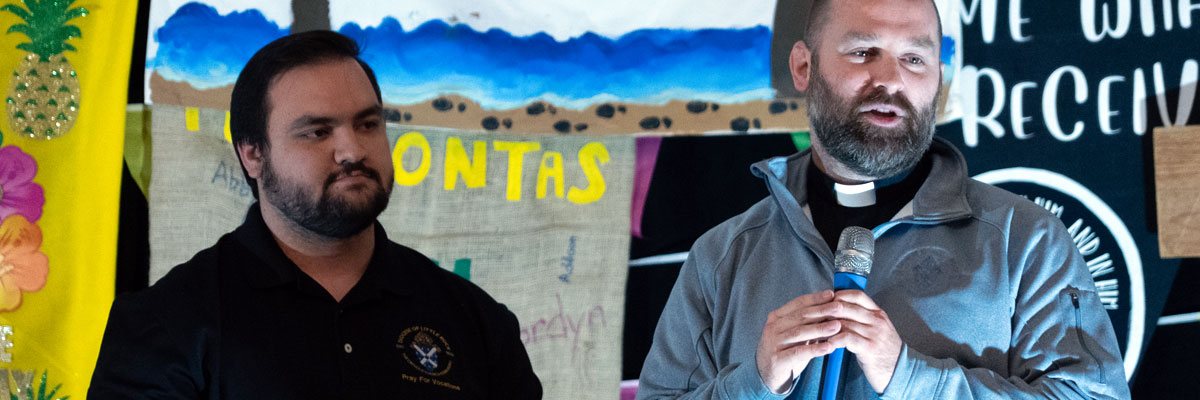Official Website of the
Catholic Diocese of Little Rock
Declaration of Invalidity (Annulment)
Procedures in a Formal Case
By law, the Church presumes that all marriages are valid until proven to the contrary. The petitioner has the burden of providing proofs to demonstrate why a marriage may be considered invalid. The formal process is not adversarial and does not make a moral judgment on any person involved, it simply makes a statement of truth regarding the validity of the prior bond according to Church teaching. The formal declaration of nullity (mistakenly called an annulment) process is necessary for the majority of cases. It includes the steps below. For more information, contact Veronica Mendez-Matthey, in the Diocesan Tribunal, at (501) 664-0340, ext. 339.
PRELIMINARY PHASE:
Preparing the Petition
The first step in this process is for the petitioner to approach his/her local parish for information about local advocates. The advocate will assist the petitioner in filling out the application and gathering the necessary information. All petitioners must provide a copy of the civil marriage certificate and the divorce decree. Catholic petitioners must also provide a copy of their baptismal certificate as well as a church marriage certificate.
The application MUST include the current mailing address for the respondent. This is necessary both for protecting the rights of the respondent, as well as obtaining proper jurisdiction to hear the case. The petitioner will need to name at least three witnesses who knew the parties prior to and at the time of the wedding. The petitioner must contact all the witnesses and confirm that they are willing to provide testimony in the matter.
The entire application must be completed, and all required documents received before the process can begin. Once the tribunal has received the petitioner's packet and all the necessary documents, and jurisdiction has been determined, the petitioner will receive a letter indicating that the case has been accepted and indicate the grounds that the court has proposed for hearing the case. The petitioner should carefully review this letter with his/her advocate to be certain the grounds proposed are clearly understood and that the petitioner has no legitimate objection to any of the members of the court named by the judicial vicar.
ACCEPTANCE OF THE CASE:
Citation of Respondent and Joinder of Issues
The court will send a certified letter to the respondent with a copy of the decree of acceptance and the decree establishing the members of the tribunal. This letter explains that the petitioner has formally started the process, and that the respondent has the right to be informed about the process, to participate, name his/her own witnesses, appoint an advocate, and to be informed about the final outcome. This letter invites the respondent to either agree with or object to the proposed grounds, to propose his/her own grounds and/or to make a legitimate objection to any of the members of the Court named by the judicial vicar
If the respondent does not object to the grounds, the judge in the case will formally determine the grounds upon which the invalidity of the marriage will be investigated and direct that the instruction of the case begin. The tribunal then notifies both the petitioner and the respondent by mail of the grounds which have been set. The tribunal then contacts the witnesses and invites them to respond to specific questions. If the respondent does not respond to either the initial citation or the second letter that stated the grounds, a third letter is sent. If the respondent still does not respond, he/she will be declared absent. The respondent still remains free to participate at any time in the process.
Instruction of the Case
All of the petitioner's witnesses are invited to provide testimony in the case. The tribunal will contact the petitioner every 30 days to advise which witnesses have or have not provided testimony. The case will not be able to proceed to the judgment process until sufficient testimony is received. If the respondent asks to have witnesses cited, the respondent's witnesses are also given a reasonable amount of time to provide testimony.
Once testimony has been received, and if the judges think it will be helpful to them in understanding the case, the petitioner or the respondent or witnesses may be asked to respond to additional questions. Depending on the grounds, the petitioner and/or the respondent may be asked to meet with a psychologist or another court-appointed expert for an interview to offer insight into the marriage.
Publication of Acts of the Case
After all of the information has been gathered from the petitioner, respondent and witnesses, the case is bound. The judge issues a decree publishing (i.e., make known to the parties) the acts of the case. This means that both parties may be given the opportunity to come to the tribunal to review all of the material that has been collected and will be used in making a decision concerning the validity or invalidity of the marriage bond.
Judgment
Thirty days after the publication of the acts, the case is concluded. It is then presented first to the defender of the bond and then to a collegiate panel of three judges. The defender of the bond does not decide the case. The defender ensures that all procedural elements have been followed and that all rights have been respected. If the defender does not believe the process has been followed according to canon law, this will be noted accordingly. It is the responsibility of the defender to point out all things that support the presumption of validity that every marriage bond enjoys by reason of church law.
The court of first instance generally consists of a three judge panel. Judges are appointed by the bishop and have a degree in canon law or have been given a dispensation from Rome to act in this capacity. Once the review is complete, the judges can begin to develop a decision. The judges may request additional testimony from existing or new witnesses and/or request input from a court expert.
Publication of Sentence and Appeals
After the tribunal judges review the case, a definitive sentence will be written. This decision contains an application of the grounds and church law to the facts of the case as well as the argument leading to the court's conclusion. Both parties and their advocates will then be notified of the decision.
If the judges decide that the evidence supports an affirmative decision in favor of a declaration of nullity, the case does not end here. If neither party chooses to appeal within three weeks, all affirmative decisions are automatically sent to a court of second instance for the next review. Once the second instance court review is completed, the parties and their advocates will be notified of the final decision. Prior to receiving this final decision, NO PLANS for a marriage in the Catholic Church can be made.
If the judges decide that the evidence does not support a declaration of nullity and give a negative decision, unless one of the parties wishes to appeal, the case ends there. In the case of a negative decision, the bond of marriage is upheld because the presumption of the validity of the marriage has not been overturned and therefore neither party is free to remarry.
Whether the decision is affirmative or negative, the petitioner, respondent and defender of the bond all have a right to appeal the decision. In order to appeal the decision, a party must send a written request to the tribunal within three weeks of the date the person is notified stating that he/she wishes to appeal the decision. Decisions of the Little Rock tribunal can be appealed to the provincial second instance court in Oklahoma City, Oklahoma or to the tribunal of the Roman Rota in Rome, Italy.









